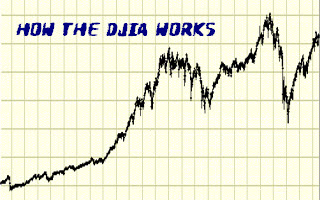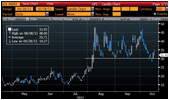
Upon speaking with many traders and investors over the years, I found it rather surprising how many of them had almost no clue how the Dow Jones Industrial Average ($INDU) really works, or even less how it is calculated. If you want to succeed, you better know the subtle rules and intricacies of the games you’re playing. Understanding how an index as critical as the DOW is calculated would certainly fall into that category. Ironically, it is so shockingly simplistic, you will like have an “aha” moment as you understand why (besides inflation), the DJIA tends to exhibit such a strong upward bias.
While most broadly followed market indices today are “cap-weighted”, such as the S&P 500, the Nasdaq, and the Wilshire, the DOW is a “price-weighted” index (as are all of the DOW indices). In a “cap-weighted” index, large price moves in the largest components have a much more dramatic effect on the value of the index. So, if you have a company such as Apple that now has a market cap north of $300 Billion, you can see how much greater an effect that one company can have on an index over many other components. However, you can make a point that such size brings clout, huge liquidity, and a huge shareholder base, so this potentially justifies its extra weight.
Regardless of any criticism you may have on the “cap-weighted” approach, the “price-weighted” method used to calculate the DOW will leave you with even more room for question. Equal importance is placed on all stocks in the index, with each company’s stock price adjusted by a divisor, then added together. The net effect of this is that share price alone becomes the most important criteria for maximum effect on the value of a “price-weighted” index! For example, if you have a $10 Million company trading at $200/share, and a $100 Billion company trading at $20/share, the $10 million company will effect 90% of the value of the index, and an equal move in the $100 Billion company will effect a mere 10% of the index value.
The DJIA divisor is updated periodically and adjusted to offset the effect of stock splits, bonus issues, dividend payouts, or any changes in the companies that form the index. When the DOW was originally created back in 1896, there were only 12 initial components that were simply divided by 12. In 1928, the number of stocks was raised to 30. Now, let’s say that our most expensive stock is currently trading at $100 and it has a 2:1 split to $50/share and causes the index to drop by 10%. The divisor is used to readjust the index to its pre-split level. This is all well and good, except for the fact that all these changes over the years have reduced the divisor to miniscule levels that now have a HUGE multiplier effect. This dramatically increases the overall volatility of the index, especially with a large price move in a high-priced component.
For example, in June, 2009, General Motors and Citigroup were removed from the index, and Cisco and Travelers took their place. With so many splits and changes over the years, the current divisor value is now a tiny 0.132129493. In layman’s terms, for every $1 change in the price of a stock in the average, you can expect to see a 7.57 point change in the DJIA index (1 / 0.132129493). So take a moment to think about this in terms of the 30 DOW stocks. Most of the movement you see on a daily basis is caused by the top few highest price stocks, which currently include IBM (leading way ahead at $175/share), followed by CAT (at $107/share), and then CVX (at $105/share). Bank of America is at the bottom of the list at around $10.50/share.
Now think how much easier it is to get a $1 price move on a $100 stock versus a $10 stock, and it’s pretty easy to see how index volatility can explode when a high-priced component exhibits a large change in price. In addition, the more component stock prices increase, the more volatile the index becomes, and the greater the likelihood we will routinely see moves that average several hundred points a day.
You may have figured that with this technique, the DOW also seems inherently rigged to continually move higher. For those pundits who’ve called for DOW 1,000 again and again, take a moment to think about this possibility. Besides the obvious effects of inflation, how could that really ever happen? Every time a few stocks in the index fall heavily out of favor (or are on the verge of bankruptcy), they are replaced with much more solid companies, trading with much higher stock prices, and generally at a time when the market has already experienced a large correction. In fact, had you simply bought the DOW after the component-change announcement was made in June 2009 (or even better, a few of its highest price components), you would have fared quite well in the market since then.



 RSS feed for comments on this post.
RSS feed for comments on this post.














